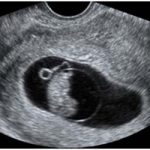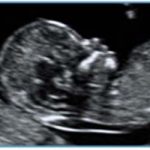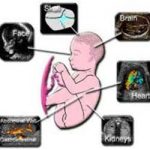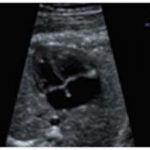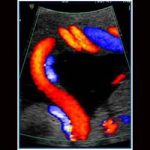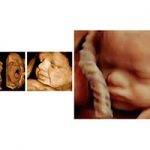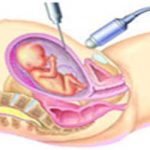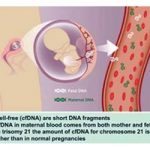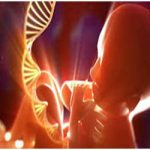How your baby develops?



The average duration of pregnancy is 40 weeks (from the last menstrual period).Doctors measure the duration of pregnancy from the first day of last menstrual period, not from the day you conceive. So when you are four weeks pregnant, it is actually about 2 weeks after you have conceived. If the last period date is not sure or if your periods were irregular then early scan will be very useful to calculate the delivery due date.
Developing baby during early stage of life is called embryo and from about 8 weeks onwards it is called a fetus.
✓ Week 3:
This is 3 week from the first day of your last menstrual period and at this stage you still don’t know that you are pregnant! The fertilised egg travels to uterus from the fallopian tube and starts dividing into cell mass and attaches to the uterus (implantation of the embryo).
✓ Week 4-5:
The actual size of the embryo at this stage is about 5mm.The cells of the embryo at this stage differentiate into different layers. One layer becomes brain, nervous system, skin, eyes and ears. Another layer becomes lungs, stomach and intestine. The third layer becomes heart, blood, muscles and bones. At fifth week only you start realising that you are pregnant and urine pregnancy test will be positive by this time.
✓ Week 6-7:The heart begins to beat and can be seen on ultrasound scan.ears,eyes,limb buds are started growing and the embryo is now about 10mm(1cm)long from head to bottom.
✓ Weeks 8-9:
The baby’s face, mouth, tongue, toothbuds, palatedevelops. Eyes have some colour in them. Fingers and toes appear and all the major organs –brain, heart, lungs, kidneys, liver and gut are all developing. The size of the baby is about 22mm.
✓ Weeks 10-14:
The fetus is fully formed now and looking like a human being! From now on your baby will grow and mature. The baby already started moving inside but you will not be able to feel yet.
✓ Weeks 15-22: Baby is now growing faster than at any other time in their life! The hair, eyebrows and eyelashes are beginning to grow. Baby already has its own individual fingerprints and the nails are growing. Between 16-22 weeks you will usually start feeling the baby’s movements for the first time. If it is your second baby usually this will be earlier. At about 22 weeks, baby’s body covered with a very fine soft hair (called as lanugo) and it disappears before or soon after birth. The actual size of the baby at 22 weeks is around 27cm.
✓ Weeks 23-30:
Your baby is now responding to touch and sound. A loud noise close by make them jump and kick!Your baby is able to recognise your voice now! Sensory development is well underway, with your baby’s ability to taste, smell, hear, see and touch all developing in their specialised areas of the brain. Your baby also now sleeps and wakes at regular times and has started to exercise its lungs and practice breathing techniques in preparation for life in the outside world. Baby swallows amniotic fluid in which they are floating and passes urine back into the amniotic fluid and again drinks back their own urine! And this cycle continues. Baby kicksstronger now and even you can sometimes feel the jerk of hiccup! Baby is covered with white, greasy substance called vernix and this protects their skin. At around 26 weeks the baby’s eyelids open for the first time.
✓ Weeks 31-40:
Your baby continues to grow. Head usually faces downwards and towards the end head moves down into the pelvis (engagement).The full-term is considered anytime from 37 weeks. Nobody knows quite what triggers labour to begin, but only 4% of babies arrive on their due date! Majority will deliver 1 week either side of expected date of delivery.
Few important structures:
✓ Umbilicalcord: This is baby’s lifeline and it links between you and your baby. Blood circulates through the cord, carrying oxygen and food to the baby and carrying away waste again.
✓ Placenta: Placenta is attached to uterus. In the placenta oxygen and food from your blood pass into baby’s blood through umbilical cord. Therefor for the proper development of the baby good placental function is vital.
✓ The amniotic sac: Inside the uterus, the baby floats in a bag of fluid called amniotic sac. This has a cushion like protection effects, maintains inside temperature and also gives additional space while baby is developing inside. Before or during labour the sac, or membranes break and this is called water breaking. If this happens very early on pregnancy then this will have adverse effect on baby.
Abnormalities during development:
✓ If the embryo does not travel to uterus (womb) and gets implanted in the fallopian tube itself then it is called as Ectopic pregnancy. An ectopic pregnancy happens in 1 out of 50 pregnancies. In this condition pregnancy will not continue and the part of the effected tube needs to be removed by an operation. The main symptoms are lower abdominal pain, minimal bleeding during early on pregnancy. This condition is usually diagnosed based on clinical suspension, ultrasound scan and by measuring pregnancy hormone levels in the body. Ectopic pregnancy if not diagnosed early on can sometimes dangerous as the involved fallopian tube can rupture causing sudden heavy bleeding and this can be can be life-threatening. Women who had pelvic or abdominal operation, pelvic infections, endometriosis, previous ectopic pregnancy and those who have undergone fertility treatments or are using fertility medications are at increased risk of having an ectopic pregnancy.
✓ Genetic abnormality in the embryo, hormonal imbalance, infections, problems inside uterus etc. can cause miscarriage (abortion) and in some cases there may not be any cause at all. Unfortunately about 15% of all pregnancies can end like this.
✓ If instead of 1 egg, 2 eggs are fertilised by 2 sperms or after fertilisation the single embryo divides into 2 then, twin pregnancy develops. The first situation leads to non-identical and the second one identical twin. This occurs in about 1 in every 70 pregnancies. The symptoms are you will have more vomiting, more tired and tummy size will be more.
✓ Abnormal development of trophoblastic tissue (future placenta) can lead to condition called molar pregnancy. The symptoms are bleeding,pain,excessive vomiting and sometimes tummy is overgrown for the gestation. Abnormally fluid filled placenta looks like bunch of grapes. Therefore expulsion of grape like vesicles per vaginum is diagnostic of vesicular mole, but this is not the usual case. Ultrasound examination is often diagnostic. This condition requires early treatment and careful monitoring afterwards as rarely a molar pregnancy can lead to a cancerous tumour.
✓ As first 3 months is the crucial phase of development –few medications-ray exposuresduring this period, some of the infections (Rubella, Cytomeagalovirus, toxoplasmosisetc.) can cause structural abnormalities in the developing foetus.
✓ Intrinsic developmental defects (most of the times cause is unknown) during development of the fetus can lead to various abnormalities this could be structural, chromosomal or genetic defects. Fortunatelythis problem occurs only in around 2% of pregnancies.

